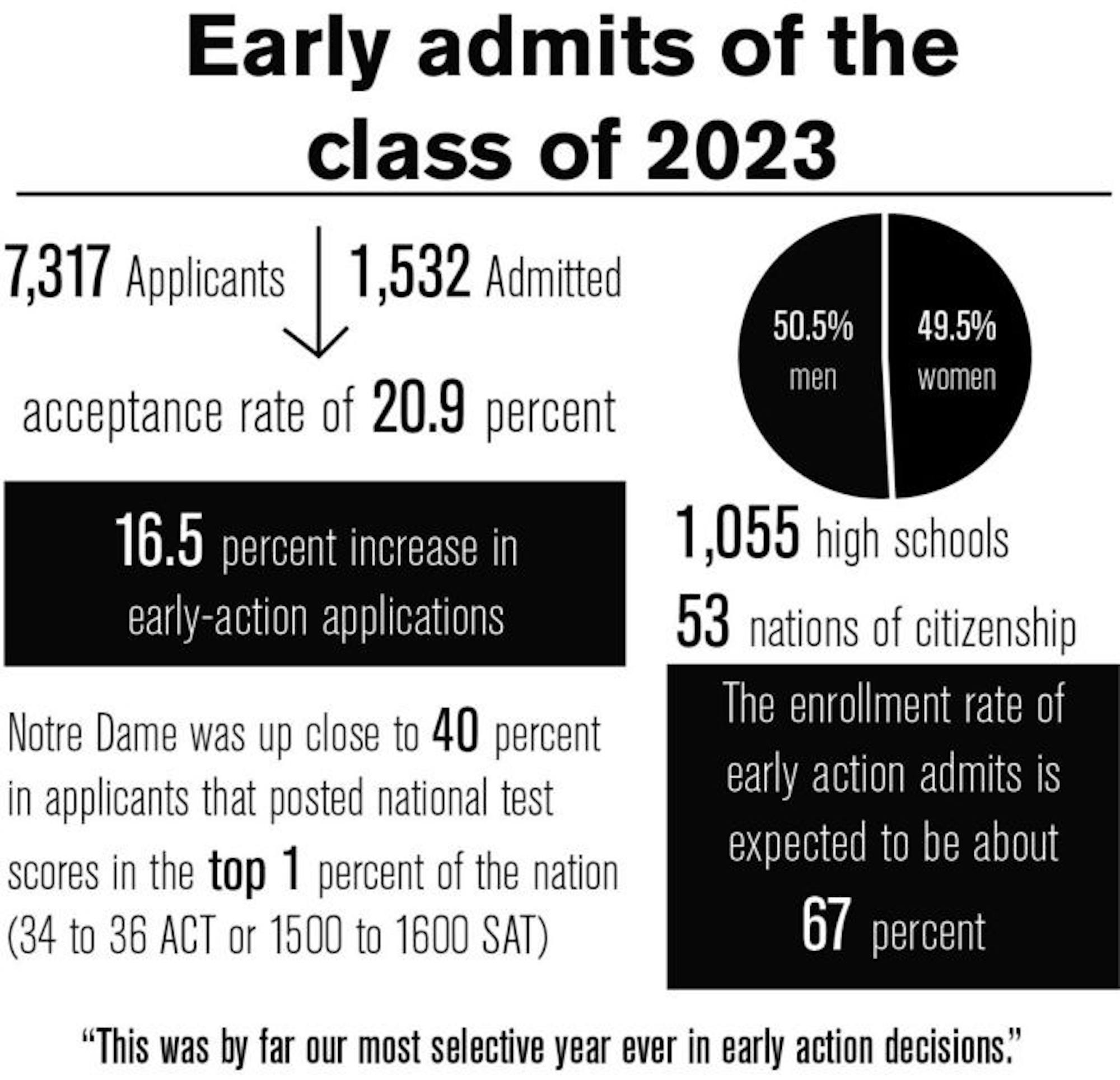Notre Dame released admissions decisions to its Restrictive Early Action (REA) applicants Dec. 14. Out of 7,217 applicants, a total of 1,532 were invited to the class of 2023 — roughly 21 percent — making this round of REA the most selective ever.
One-hundred-twelve fewer students were admitted this year than last year. According to Don Bishop, associate vice president of undergraduate admissions, this was because Notre Dame’s yield rate — the percent of admits choosing to enroll — continues to grow. In 2018, the total yield rate for all applicants — early and regular — went from about 55 percent to 57 percent. For REA admits only, the yield rate increased to about 67 percent. This puts the University in the top-10 highest yield rates for higher education institutions.
Bishop said Notre Dame also aims to save more than half of applicants for the regular admission pool, lowering the number of students accepted this year. Additionally, Bishop said, applying early does not give students an inherent advantage, as most students applying early are at the top of the applicant pool.
“The reason [applicants] apply early is that there’s nothing more they can do. They’re already at the top already, so they might as well apply,” Bishop said. “Lower-income households, first-generation households don’t apply as early and want more time to decide and spend more time applying … so the higher percentage of class that you cash in early may create an equity of access in regular action. A higher percentage of those groups come in the regular action pool, so if you overstuffed the first early fruit, you’ve really eliminated — to some degree — opportunity, and we don’t want to do that.”
This REA group also is a diverse one — about 13 percent of the class is made up of either international students, dual citizens, or U.S. students abroad; first-generation student admits are up by 16 percent from last year; the number of U.S. students of color admitted through REA is up 15 percent; and 53 nations are being represented in the class.
“We’ve gone out and identified more low-income students, and made sure that they knew Notre Dame was very encouraging to them,” Bishop said. “We have a lot of people that send us their test scores … so we have some interaction with them that they started, but we are trying to do more interaction with students that we start. We have been trying to find more students that are from first-generation households by creating relationships with community-based organizations where they know where the low-income, high-achieving students are.”
According to the release, the number of REA applicants is up 16.5 percent from 2017’s REA application round — an increase of 1,036 applicants.
Bishop said he attributes this increase to the several steps the University has taken to continue the upward trend in applicants.
“Part of it is that we’re doing a better job in the admissions recruitment effort,” he said. “Secondly, the campus development — all the new buildings — the campus just presents well. Also, the success of Notre Dame alumni, and the students have really gotten very involved in helping us recruit the next wave of students.”
This year, 1,375 applicants — 19 percent— were deferred to the regular decision pool. Bishop said, on average, about 100 applicants are accepted during the regular application round. If an applicant is deferred, Bishops advises them to demonstrate they are still interested in attending, and update the University on any changes in their grades, activities or awards.
“We don’t want them to feel like they have to campaign, but they can send us any major updates to their transcript,” Bishop said.
The admissions department looks for more than just grades; they look for students who have demonstrated motivations behind their accomplishments, a desire to go beyond just academics and to be of service to others, Bishop said.
“In the end, it’s a balancing of your academic talent and potential, and some students have more potential that don’t come from all the resources that other students come from. So when we see that there is a talent level, if you give them the Notre Dame resources, we think that they will jump in performance higher than some other students who’ve come from enormous resources,” Bishop said. “Some of these students are more impressive to us, and we think that long term they are going to be, in some cases, the more dynamic people that will be Notre Dame graduates and serving in the world and not just serving their own success.”
University welcomes early admits for class of 2023
Claire Kopischke | The Observer
Claire Kopischke | The Observer









